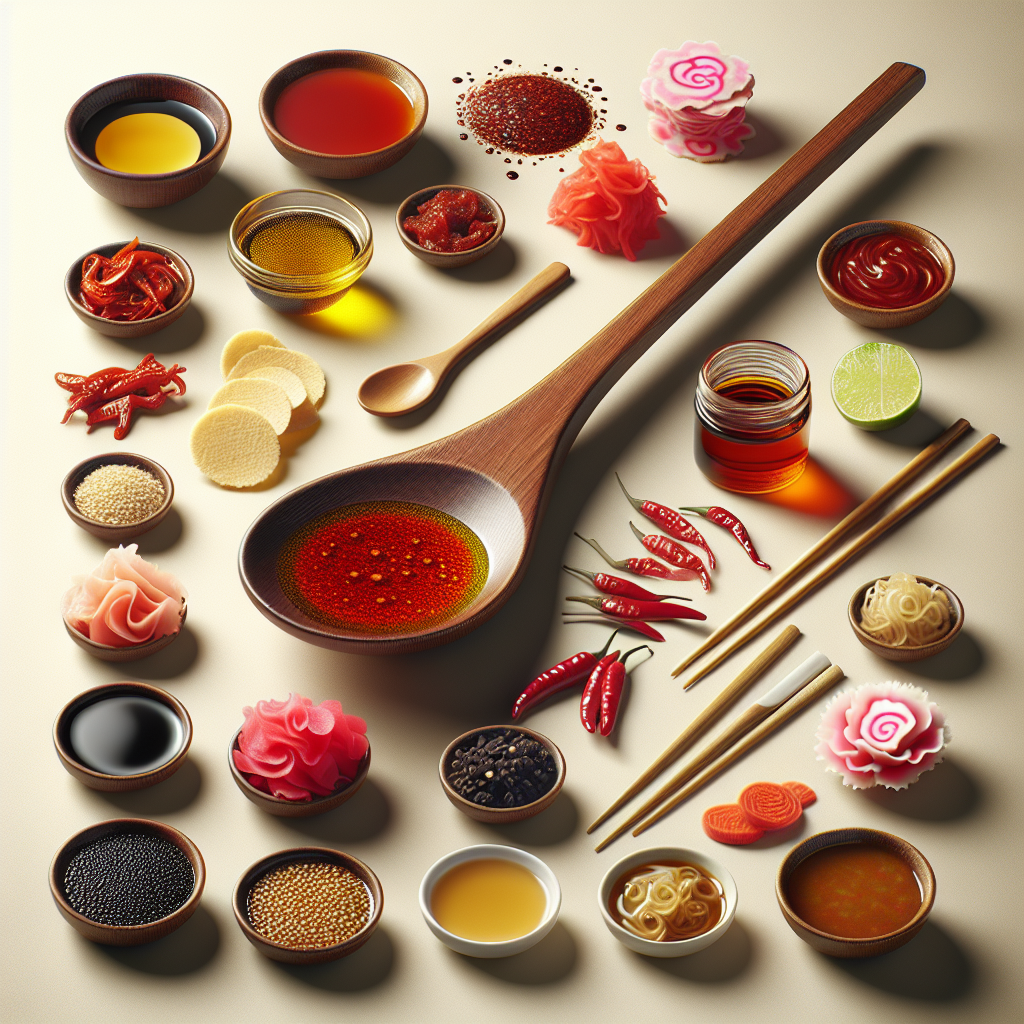Get ready to embark on a culinary adventure as you delve into the world of popular ramen condiments! Whether you’re a ramen-fanatic or just getting acquainted with this savory dish, you won’t want to miss out on the mouthwatering flavors these condiments bring to the table. From fiery chili oil to tangy pickled ginger, each unique addition enhances the already delectable flavors of your favorite bowl of ramen. So grab your chopsticks and get ready to explore the diverse and delicious world of ramen condiments!
Serve up your ramen in these popular bowls
Exploring Popular Ramen Condiments
Ramen is a delicious and hearty Japanese dish that is loved by people all over the world. While the noodles and broth take center stage, it’s the condiments that elevate the flavors and make each bowl of ramen unique. In this article, we will delve into the world of popular ramen condiments and discover how they can enhance the flavor of your favorite noodle dish.
Soy Sauce-Based Condiments
Soy sauce is a staple in Asian cuisine and plays a vital role in many ramen recipes. It adds depth and complexity to the broth, giving it a rich umami flavor. There are three popular soy sauce-based condiments that are commonly used in ramen:
Regular Soy Sauce
The most basic and widely available condiment is regular soy sauce. It is a versatile condiment that adds saltiness and enhances the natural flavors of the broth. Regular soy sauce is a great choice if you’re looking for a simple way to enhance your ramen.
Tamari Soy Sauce
Tamari soy sauce is a gluten-free alternative to regular soy sauce. It has a slightly richer and smoother flavor, making it a popular choice for those with dietary restrictions or preferences. Tamari soy sauce adds a distinct earthiness to the ramen broth, giving it a unique twist.
Shoyu Tare
Shoyu tare is a concentrated soy sauce-based seasoning that is often added to ramen for an extra burst of flavor. It is made by reducing soy sauce, mirin, and other seasonings to create a thick and flavorful sauce. Shoyu tare adds a savory and slightly sweet taste to the broth, taking your ramen to the next level.
Miso-Based Condiments
Miso is a traditional Japanese ingredient made from fermented soybeans. It is known for its rich and hearty flavor, making it a perfect addition to ramen. Miso-based condiments add a creamy and savory element to the broth, creating a delightful balance of flavors. Let’s explore the most common miso-based condiments used in ramen:
White Miso
White miso is a mild and slightly sweet miso paste. It has a creamy texture and a subtle tanginess that enhances the overall flavor of the ramen broth. White miso is a popular choice for those who prefer a lighter and less intense miso flavor.
Red Miso
On the other end of the spectrum, we have red miso, which is a darker and bolder miso paste. It has a stronger and more robust flavor, adding depth and complexity to the ramen broth. Red miso is a great choice if you’re looking to intensify the umami notes in your ramen.
Awase Miso
Awase miso is a blend of both white and red miso. It combines the best of both worlds, offering a balanced flavor profile that is neither too mild nor too overpowering. Awase miso is a versatile condiment that can be used in various ramen recipes to create a harmonious blend of flavors.
Chili Oil
If you’re a fan of spicy food, then chili oil is a must-have ramen condiment. It adds a fiery kick to the broth, elevating the entire dish to new levels of deliciousness. There are several types of chili oil commonly used in ramen:
Classic Chili Oil
Classic chili oil is made by infusing vegetable oil with dried chili peppers and other aromatic spices. It adds a smoky and slightly sweet heat to the ramen broth, giving it a tantalizing kick. Classic chili oil is perfect for those who enjoy a milder spiciness in their ramen.
Spicy Chili Crisp
Spicy chili crisp is a popular Chinese condiment that has made its way into the realm of ramen. It is made by frying chili peppers, garlic, onion, and other seasonings in oil until crispy. Spicy chili crisp adds a crunchy texture and a robust spiciness to the broth, adding layers of flavor to your ramen.
Rayu (Japanese Chili Oil)
Rayu, also known as Japanese chili oil, is a fragrant and spicy condiment that is often used in ramen. It is made by infusing sesame oil with chili peppers, garlic, and other seasonings. Rayu adds a distinctive nuttiness and a fiery heat to the broth, creating a truly invigorating ramen experience.
Serve up your ramen in these popular bowls
Garlic Paste
Garlic lovers rejoice! Garlic paste is a popular ramen condiment that adds a pungent and aromatic flavor to the broth. It is made by mashing fresh garlic cloves into a paste, creating a concentrated burst of garlicky goodness. There are two common types of garlic paste used in ramen:
Fresh Garlic Paste
Fresh garlic paste is made by finely mincing fresh garlic cloves and mashing them into a paste. It adds a strong and sharp garlic flavor to the ramen broth, infusing it with an intense aroma. Fresh garlic paste is perfect for those who enjoy the bold and robust taste of garlic.
Fried Garlic Paste
Fried garlic paste is created by sautéing minced garlic in oil until golden brown and crispy. It offers a more subtle and mellow garlic flavor compared to fresh garlic paste. Fried garlic paste adds a unique texture and a gentle garlic taste to the ramen, enhancing its overall complexity.
Sesame Seeds
Sesame seeds are a popular ingredient in Asian cuisine, adding a delightful nutty flavor to dishes. They are often used as a topping in ramen, providing a satisfying crunch and a burst of taste. Let’s take a closer look at the different types of sesame seeds used in ramen:
White Sesame Seeds
White sesame seeds are the most common type of sesame seeds used in ramen. They have a mild and slightly sweet flavor that pairs well with the rich broth. White sesame seeds offer a subtle nuttiness and a beautiful contrast to the other ingredients in the ramen bowl.
Black Sesame Seeds
Black sesame seeds are a less commonly used but equally delicious option for ramen toppings. They have a stronger and more robust flavor compared to white sesame seeds. Black sesame seeds add a deep earthiness and a visually striking element to the ramen, making it a feast for the eyes and the taste buds.
Toasted Sesame Seeds
Toasted sesame seeds take the nutty flavor of sesame to a whole new level. They are often roasted before being sprinkled on top of ramen, intensifying their taste and aroma. Toasted sesame seeds offer a unique smokiness and a delightful crunch to the dish, making it a truly satisfying experience.
Green Onions
Green onions, also known as scallions or spring onions, are a classic ramen topping that adds a fresh and vibrant flavor to the dish. They are widely used in Asian cuisine for their mild onion taste and crisp texture. Here are a few variations of green onions commonly found in ramen:
Scallions
Scallions are young onions with long green stalks and slender white bulbous roots. They have a milder flavor compared to regular onions, making them a popular choice for ramen toppings. Scallions add a refreshing and slightly pungent taste to the ramen, balancing out the richness of the broth.
Chives
Chives are a close relative of scallions and offer a similar flavor profile. However, they are smaller in size and have a delicate and subtle onion taste. Chives are often used as a garnish in ramen, adding a touch of elegance and a gentle onion aroma to the dish.
Onion Sprouts (Negi)
Onion sprouts, also known as negi, are the sprouted greens of the onion plant. They have a mild and slightly sweet flavor, making them a versatile and flavorful ramen topping. Onion sprouts offer a delightful crunch and a vibrant green color to the bowl, enhancing its visual appeal and taste.
Corn
Corn may seem like an unconventional ramen topping, but its sweet and juicy kernels make for a delightful addition to the dish. It adds a burst of natural sweetness and a pleasant texture to the ramen. Corn is a popular choice for those who crave a touch of sweetness and a hint of summery flavor in their bowl of noodles.
Nori (Seaweed)
Nori, also known as dried seaweed, is a classic ramen topping that adds a unique umami flavor and a delightful crunch. It is thin, paper-like sheets that are usually toasted before being added to the dish. Let’s explore the different types of nori commonly used in ramen:
Dried Nori Sheets
Dried nori sheets are the most common form of nori used in ramen. They have a slightly briny and oceanic taste, adding a distinct umami flavor to the broth. Dried nori sheets are usually torn into smaller pieces and sprinkled on top of the ramen, creating a visually appealing and flavorful garnish.
Seasoned Nori Sheets
Seasoned nori sheets are dried nori sheets that have been seasoned with various spices and seasonings. They come in different flavors such as wasabi, sesame, or soy sauce. Seasoned nori sheets offer a more intense and complex taste compared to plain dried nori, giving your ramen an extra kick of flavor.
Bamboo Shoots
Bamboo shoots are a unique ramen condiment that adds a subtle crunch and a delicate taste to the broth. They are the edible shoots of the bamboo plant and are often sliced or julienned before being added to the dish. Let’s explore the different types of bamboo shoots used in ramen:
Menma
Menma is bamboo shoots that have been marinated in soy sauce or other seasonings. It has a slightly tangy and savory flavor that pairs wonderfully with the ramen broth. Menma offers a satisfying chewiness and a visually striking element to the bowl, making it a popular choice for ramen enthusiasts.
Serve up your ramen in these popular bowls
Kamaboko
Kamaboko is a processed seafood product made from pureed fish. It is often shaped into a loaf or a tube and sliced into thin rounds before being added to ramen. Kamaboko provides a delicate and slightly sweet flavor, adding a unique texture and an aesthetically pleasing touch to the dish.
In conclusion, ramen condiments are the secret ingredients that elevate a bowl of noodles from good to extraordinary. Whether you prefer the richness of soy sauce-based condiments, the depth of miso-based condiments, the fiery kick of chili oil, the pungent aroma of garlic paste, the nutty flavor of sesame seeds, the freshness of green onions, the sweetness of corn, the umami taste of nori, or the delicate crunch of bamboo shoots, there is a ramen condiment out there to suit every palate. So, next time you enjoy a bowl of ramen, don’t forget to experiment with different condiments to create a personalized and delicious experience. Happy ramen slurping!
Happy Cooking!


